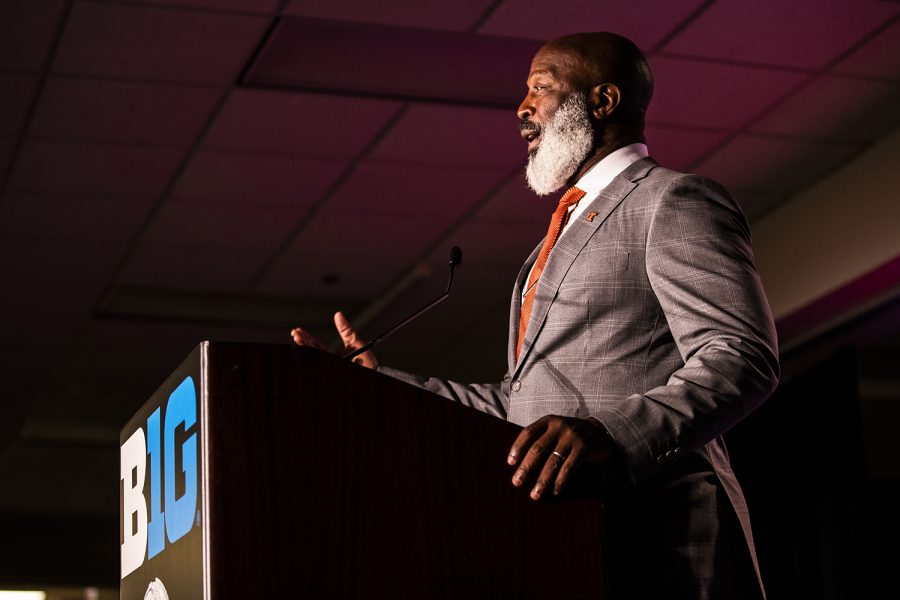Emerging Big Ten West strengthens conference
The Big Ten West should now be known as the Wild West, with multiple programs developing and rebuilding to compete with its traditionally stronger counterparts in the East.
Illinois head coach, Lovie Smith, speaks during the Big Ten Football Media Day in Chicago, Ill., on Thursday, July 18, 2019.
July 18, 2019
CHICAGO – In 2012, then-Wisconsin head coach Bret Bielema commandeered the Badgers to a Big Ten title win over Nebraska, 70-31. It was the last time a school currently in the Big Ten West was crowned with a conference championship. (Though the divisions had different names, and Wisconsin was in the geographically more eastern division.)
Seven years later, the makeup of the conference is quite different. The arrivals of Rutgers and Maryland to the conference led to the 2014 restructuring of the East and West, replacing the former Legends and Leaders Divisions. Since then, the Big Ten East has dominated in recent years — Ohio State, Penn State, and Michigan State have swept the conference title for the East in the last five seasons. So some pundits and football czars have called for another restructure.
Emerging coaches in the West conference don’t take these ideas seriously.
In the last three years alone, three schools that have been largely dormant in the last decade have made massive hirings in the coaching carousel. P.J. Fleck of Minnesota, Lovie Smith of Illinois, and Scott Frost of Nebraska have all filled out what is becoming the strongest group of coaches in the history of the West Division.
“I have so much respect for everybody in this league, East and West,” Fleck said. “But when you look at the West, which I’m a part of, you look at the coaches who have come into this league or the coaches who were here when I got here, and it’s like ‘Wow.’ It’s changing.”
Fleck is entering his third season as a coach in the Big Ten after strong years in the Mid-American Conference. His courting by Minnesota came after an unbelievable turnaround at Western Michigan. The Mustangs went 1-11 in 2013 in his first year but flipped to a 13-1 record and a Cotton Bowl appearance in 2016.
And Minnesota has started to compete again. Months later, Fleck continues to flaunt his team’s victory in 2018 over rival Wisconsin, and for good reason: It was the first time the Badgers handed over Paul Bunyan’s Axe to the Gophers in 14 years, a sign of an emerging program in Minneapolis.
These are good signs for the West Division. Though none of the coaches are concerned with politics of restructuring, they are deeply concerned with elevation of their programs, which of course, is good for the division.
Frost doesn’t have Big Ten tradition at the top of his list of worries, but bringing Nebraska back is an urgent concern. He went home to coach alma mater Nebraska after coaching his undefeated Central Florida team to a Peach Bowl in 2017, leading to the Black Knights name themselves national champions.
RELATED: Nebraska looking forward to matchup with Iowa
But the former Husker quarterback — who led the team through great times in the 1990s — is back in Lincoln.
“If I’m being honest, the West hasn’t been as good as it should be, because Nebraska hasn’t been as good as it should be,” Frost said. “We can do a lot of the work that we’re doing to get our program where it belongs to help the West be competitive and just as dominant as any other in the country.”
He’s got a point. Though Nebraska didn’t join the Big Ten until 2011, it hasn’t taken any conference titles since it won the Big 12 in 1999. Its quiet behavior since its addition to the Big Ten has clearly dimiinshed the strength of the West and the Big Ten as a whole.
Former Chicago Bear, now Illinois head coach Smith has taken a similar approach, believing that his own team’s success elevates that of the conference and the West. But when asked about the better play of his rivals, Smith had only positive things to say about his own program.
“I don’t know about a lot of them [being successful], I like that one team that kind of faded down in the bottom last year,” Smith said, almost tongue-in-cheek. “The University of Illinois is one I really kind of like. Young team coming up, lot of positives, new facility coming around, a lot of excitement right now. I know them in detail a little bit.”
Smith’s leading of the resurgent Illini program — as he mentioned — led to building of an $80 million facility for the football team in Champaign. Similar projects recently finished in Evanston for Northwestern, where the $260 million facility right on Lake Michigan has been called by many the best in the country.
“Everybody’s talking about conference [realignment], and let’s redo that – just give it a few years,” Fleck said. “Let it play out with some of these guys who have just gotten jobs, and we’ll see how both sides elevate.”



